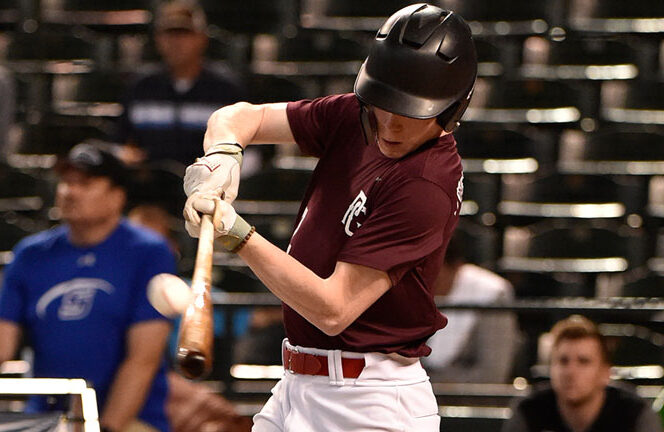
Pete Crow-Armstrong/Photo by Perfect Game
The first 37 picks of the shortened 2020 amateur draft have come and gone, and this draft will be remembered for a long time. The draft will not only be historic because of circumstances; the class of talent is exceptional and the first round was met with some surprising shake ups early on.
The Tigers shocked absolutely no one by taking ASU slugger Spencer Torkelson. However, they did turn quite a few heads by announcing him as a third baseman, rather than a first baseman. Though Torkelson has every chance to wind up at first base, this erases a potentially historic first selection. No right-handed hitting college first baseman had ever been selected first overall. That was a streak believed to be ending until the Tigers switched positions on Torkelson.
After Detroit picked is when a couple of legitimate surprises went down. The Orioles disregarded the consensus second-best and third-best prospects in Vanderbilt’s Austin Martin and Texas A&M lefty Asa Lacy, and instead selected Arkansas outfielder Heston Kjerstad. Kjerstad has the best raw left-handed power in this draft and was projected to get picked in the 7-to-12 range. Picking him likely saves the O’s a fair bit of money in their draft pool.
With Martin and Lacy still on the board for the Marlins with the third selection, they once again shocked the industry in taking Minnesota right-handed Max Meyer instead. Meyer is less of a reach than Kjerstad may be. He was one of the names supposed to go immediately after the top three. The 5’10” right-hander touches triple digits with his fastball and features the best right-handed slider in the draft. The Marlins already reportedly have a deal with Meyer as well, likely nabbing him for a little bit under the slot value.
Max Meyer (@mxmeyer22) had:
▪️The highest rated breaking ball in the Draft
▪️The second highest rated fastball in the Draft
▪️A 141/33 K/BB in collegeBorders on elite when it comes to stuff, command and control. Only knock: limited size. Will enter #Marlins top 10 immediately. pic.twitter.com/U6lhm3vijD
— Fish On The Farm (@marlinsminors) June 11, 2020
The rest of the top ten picks rounded out fairly predictably, with Lacy and Martin falling to fourth and fifth, respectively. The draft set a new record as the first seven selections were all college players. That trend ended with high school outfielders Robert Hassell III and Zac Veen becoming the eighth and ninth picks.
The next NL East team to select was the Phillies in the fifteenth spot. They took 6’6″ prep right-hander Mick Abel, the first high school pitcher to be taken in a year where teams seem to be relatively risk-averse. Abel is a monster, touching the upper 90s on his fastball with some arm-side run and a firm slider that sits 82-86. He is undoubtedly the best prep pitcher in this class.
Ok, Phillies fans. Here he is:
Here’s some footage of Mick Abel facing live batters at the Perfect Game Showcase.
Plus fastball and plus slider on display here — up to 97 on the gun.
Kid is an animal. pic.twitter.com/saOsAptFEc
— Alex Carr (@AlexCarrMLB) June 11, 2020
The Mets picked up Los Angeles native Pete Crow-Armstrong with the 19th selection. The prep outfielder is a defensive wizard in center field, with a high likelihood he sticks in center as a pro. He also touts plus speed and solid bat-to-ball skills. Hit hit tool outpaces his power at the moment, but he started to hit the ball with more authority more recently. The power likely grades out as average at best moving forward. The Mets seem to view Crow-Armstrong as a speedy top-of-the-order hitter who drives balls into the gap and tracks fly balls down in center.
The reigning champ Nationals took University of Oklahoma ace Cade Cavalli with the 22nd overall selection. The Nats love taking college arms in the first round. This is the fifth time in seven years they have gone that route, and they got a good one in Cavalli. He has a very clean, picturesque windup with two legitimate above-average offerings in a mid-90s fastball and a power curve. At 6’4″, he has a big-league body already. However, the knock on Cavalli is that his fastball is fairly straight, and because his motion is so clean, he does not hide the ball particularly well. Despite the frontline stuff, he gives up more solid contact than he should.
Rounding out the NL East, the Braves took Wake Forest left-handed Jared Shuster with the 25th selection. Shuster was an interesting first round choice for the Braves. He was lower on some draft boards, with most having him as more of a second round-type. Shuster likely would not have even been in consideration for a pick anywhere near this high a year ago. He was inconsistent at best in his first two years at Wake Forest, but made marked improvements last summer in the Cape Cod League, pitching to 1.41 ERA in 7 starts. He followed that up by pitching effectively this spring before the shut down, giving him some helium on draft boards. His fastball now touches 97 with an excellent change-up and a breaking ball that can best be described as a work in progress.
https://twitter.com/FOXSportsBraves/status/1270902653871063046?s=20
The Mets have five selections on the draft’s second day, beginning with picks at 52 and 69. There’s still a fair amount of talent left on the board, as this draft class is particularly deep. One notable omission from the first round is prep righty Jared Kelley, who was once seen as a potential top-ten pick. His best bet at this point is to honor his commitment to Texas because he won’t get the money he’s seeking.
Also on the board is Ohio State catcher Dillon Dingler, who features plus raw power and surprising athleticism, given that he once patrolled center field for the Buckeyes before donning the catcher’s gear everyday. Georgia righty Cole Wilcox was seen as a possibility for the Mets at 19, but slid out of the first round. Wilcox has frontline stuff, touching the upper 90s consistently on his fastball with a sharp slider and improving change. He lacks the polish of a lot of college arms that went above him, having only started ten games in his collegiate career, but the 6’5″ righty carries loads of pure stuff and athleticism.
Coverage of rounds two through five start on Thursday night at 5 p.m. ET on MLB Network. The Mets pick 52nd, 69th, 91st, 120th, and 150th. Follow along with us on @Mets_Minors

